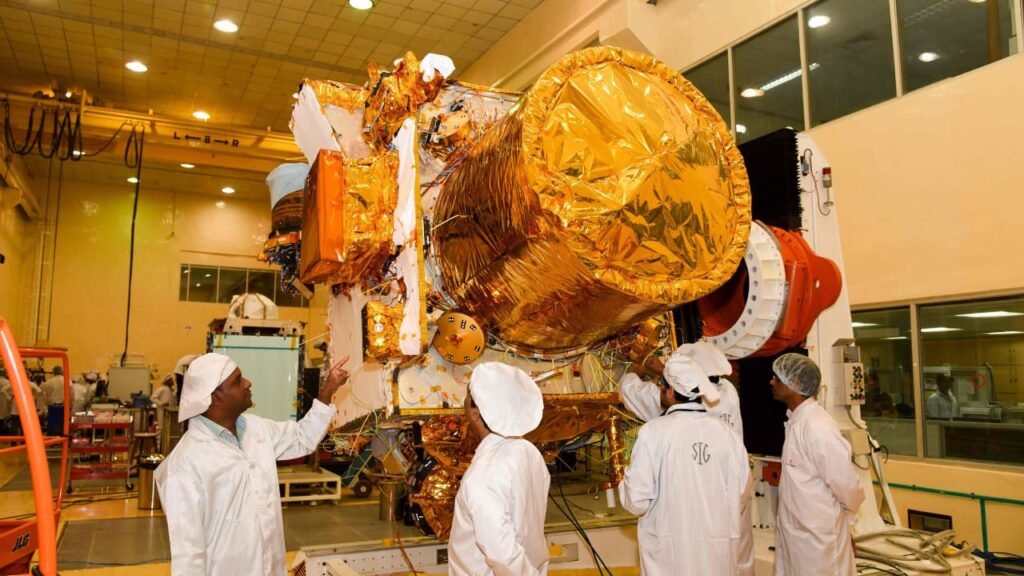
Table of Contents
India’s space journey has been nothing short of extraordinary. Did you know that ISRO launched a mission to Mars and the budget was less than the movie ‘Gravity’?
ISRO has made India proud! Over the years, the Indian Space Research Organisation (ISRO) has achieved remarkable milestones. As compared to the leading space agencies, the organization functions at a significantly lower cost.
Be it launching India’s first satellite, the globally acclaimed Chandrayaan-3 or undertaking and completing other complex missions to Mars, the Indian space journey is a testament to ISRO’s scientific excellence and innovation.
And today, through this article, we will further explore the ISRO model. We will read about its inception, growth, and journey while highlighting its key achievements and contributions to global space exploration.
ISRO’s Genesis

Where there’s a will, there’s a way!
Back in 1969, when the first human landed on the moon, our scientists embarked on a mission to explore space. The Indian Space Research Organisation’s transformational journey has been shaped by visionaries.
Dr. Vikram Sarabhai is known as the father of the Indian space program, and rightly so. Under his guidance, the exemplary journey of ISRO began. Dr. Sarabhai laid the foundation of the Indian Space Research Organisation and he recognised the immense potential of space technology for the development of the nation.
Additionally, Dr. Satish Dhawan and Dr. K. Kasturirangan shaped ISRO’s strategic direction during its early years and the former President, Dr. A.P.J. Abdul Kalam’s trailblazing work on satellite launch vehicles set new benchmarks. The current chairman, Dr Sreedhara Panicker Somanath has been instrumental in leading new initiatives and maintaining the organization’s competitive edge in the global space exploration race. These figures and countless unsung heroes continue to drive ISRO’s vision forward.
The ISRO model is about overcoming the restrictions surrounding limited resources and utilizing the space journey to benefit humanity. As of July 2023, it had launched 431 satellites for 34 countries. That is ISRO’s legacy!
Do you remember what ISRO’s logo looks like? An orange arrow, shooting upwards depicts India’s space journey. It proudly symbolizes the organization’s mission and our country’s ambitious space goals.
Here’s a question for you. Where are ISRO headquarters located? Hint: Look South!
First Milestones

Imagine, in 1981, ISRO’s first satellite, Aryabhatta was transported on a bullock cart to the launch site. Nothing less than iconic! Did you know the satellite was named after the great 5th CE mathematician and astronomer Aryabhatta by former Prime Minister, Indira Gandhi?
Evidently, in its early years, ISRO faced varied challenges. But the rocket launch scene speaks volumes about the unwavering determination of ISRO’s team. Aryabhatta was the first milestone as the rocket launch marked India’s entry into the space age.
ISRO’s landmark missions, such as the successful launch of SLV-3, India’s first satellite launch vehicle, firmly positioned the country as a formidable player in space exploration. The Polar Satellite Launch Vehicle (PSLV) has proved to be a reliable and versatile launch vehicle for ISRO, making it crucial in these missions.
In 2019, Chandrayaan-2 was launched to explore the uncharted south pole of Earth’s satellite, the Moon. The Vikram lander’s hard landing did dampen our spirits, but the mission did successfully manage to place the orbiter in lunar orbit. The Chandrayaan missions have undoubtedly provided valuable insights into lunar science.

The Mars Orbiter Mission was another noteworthy milestone. India became the first country to reach Mars orbit on its maiden attempt. Finally, with its launch in 2013, Mangalyaan demonstrated ISRO’s capability in interplanetary missions.
But ISRO’s wonders don’t cease! Down here, on the earth, the magic continues. Its NavIC helps fishermen navigate the seas and ensures your pizza delivery finds its way home. From transporting a satellite on a bullock cart to studying the Sun with the Aditya-L1 mission, ISRO’s story is filled with ambition, innovation, and a sprinkle of good old jugaad.
Global Collaborations

Global scientific research and knowledge sharing know no restrictions!
ISRO’s achievements go way beyond our national boundaries. It has proactively collaborated with various international space agencies from time to time. The result is enhanced technological capabilities and broadened research horizons.
The NASA-ISRO Synthetic Aperture Radar (NISAR) mission has grabbed headlines. The purpose of the joint Earth-observing mission is to study our planet Earth’s changing ecosystems and natural hazards, from the flow rates of glaciers and ice sheets to the dynamics of earthquakes and volcanoes.
Additionally, to name a few more, the PSLV missions and path-breaking initiatives such as the ISRO Bhuvan have secured and cemented ISRO’s reputation. A spaceport at Kulasekarapattinam has been proposed and it will strengthen the organization’s launch capabilities and further smoothen international collaborations.
ISRO’s Backbone

Let’s go back to the question at the beginning. ISRO’s headquarters are located in Antariksh Bhavan in Bengaluru. Did you get that right?
Known as the space capital of India, Bengaluru is home to various ISRO centres, including the U R Rao Satellite Centre and the Liquid Propulsion Systems Centre. It plays a crucial role in the organization’s overall functioning. The city also serves as the hub for ISRO’s administrative and strategic planning activities.
A significant contributor to ISRO’s success includes its various centres across India combined with its robust infrastructure. From research and development to satellite launching, these centres hold the fort in different critical aspects of space technology. The Indian Space Research Organisation’s headquarters in Bengaluru, the Vikram Sarabhai Space Centre in Thiruvananthapuram, and the Satish Dhawan Space Centre in Sriharikota are some of the important facilities.
FAQs Related to ISRO
How does ISRO compare to NASA?
Both these agencies collaborate on various projects, share knowledge, and work towards advancing global space research. While ISRO’s missions are more cost-effective, NASA has a larger budget and more resources. Although NASA is well known for its extensive research capabilities, ISRO’s focus on efficiency has earned it global admiration. ISRO’s Mars Orbiter Mission was completed within a budget of approximately $74 million. This is at a fraction of the cost of NASA’s Mars missions!
What makes Indian space research competitive?
Successful execution of complex space missions, innovative approach, and cost-efficiency. Indian space research maintains its competitive spirit by delivering high-quality results with budgetary constraints. ISRO strives to develop indigenous technology and foster international collaborations. Missions like Chandrayaan, Mangalyaan, and the upcoming Gaganyaan only showcase ISRO’s capability to deliver challenging projects.
What kind of career opportunities does ISRO offer?
The opportunity to work with brilliant minds to contribute to significant global space exploration efforts and be a part of cutting-edge space technology projects makes ISRO careers sought after.
For those interested, specifically engineers, scientists, and technicians, ISRO frequently conducts recruitment drives offering positions in fields such as satellite technology, launch vehicle development, and space mission planning.
ISRO careers are highly rewarding, but the recruitment process is competitive.
How does ISRO’s PSLV contribute to its success?
In 1994, ISRO’s Polar Satellite Launch Vehicle (PSLV) was launched. Known for its reliability and versatility, it is the space research organization’s most successful launch vehicle. For 29 years, it has placed many satellites like remote sensing and communication satellites into orbit.
Do you know what makes it a preferred choice for international clients? Its ability to launch multiple satellites in a single mission. PSLV’s success and ability have boosted ISRO’s reputation in the global market and firmly established it as a pivotal and cost-effective launch service provider.
ISRO’s Future
What does the future of ISRO look like?
So far, the Indian space research journey has been nothing short of illustrious. It is a persisting saga! Looking ahead, ISRO is all set for further lunar explorations and ready to embark on more ambitious missions including Gaganyaan, India’s very own first manned space mission.
These missions are indicative of ISRO’s forward-looking vision and commitment to advancing space science. India’s space research organization will continue its pioneering role in the global space community and contribute to humanity’s understanding of the universe.
As for us, the people of India, ISRO’s rise is not just about technological triumph. It is a story of national pride and global recognition. As ISRO works toward breaking new ground, let us all agree-
The sky is not the limit!
To keep getting clarity on such interesting topics, please subscribe to Clarity Circuit.
Recommended Articles
If you found this topic interesting, you might also enjoy reading these articles:


